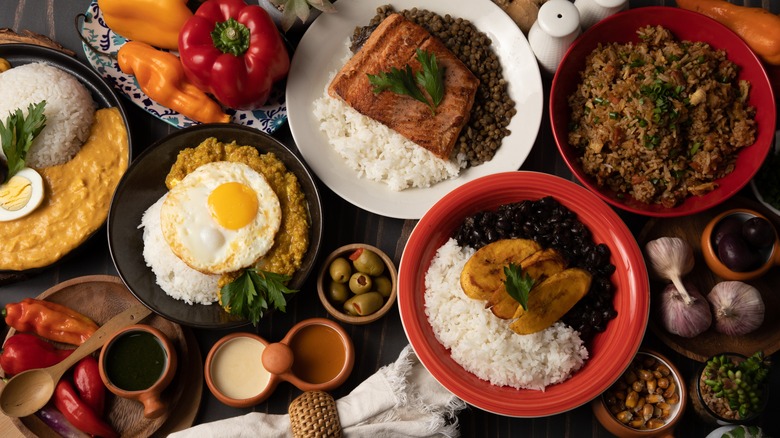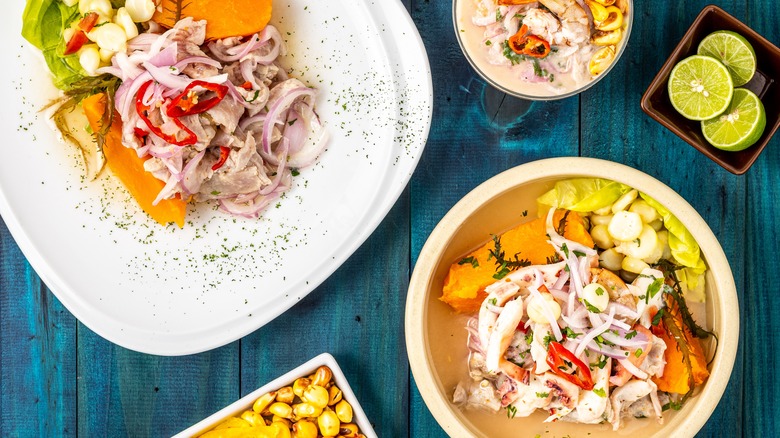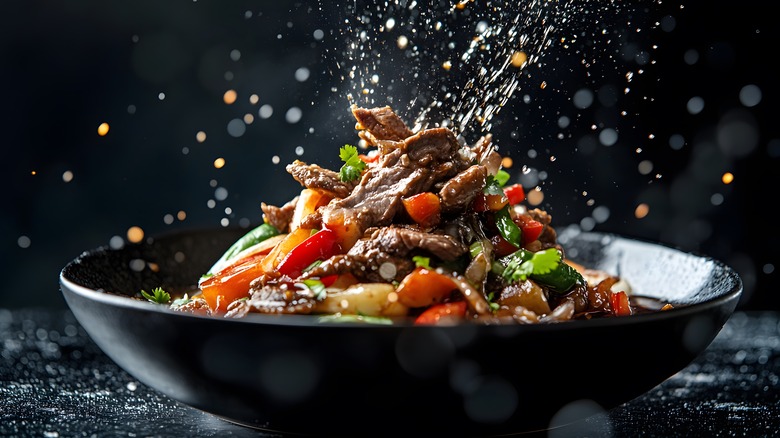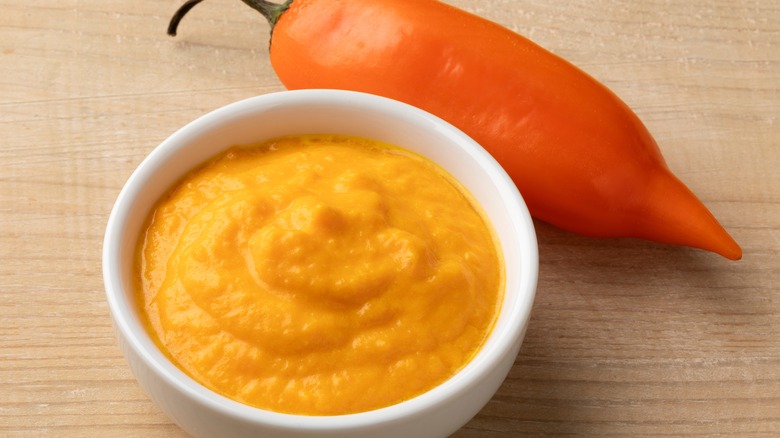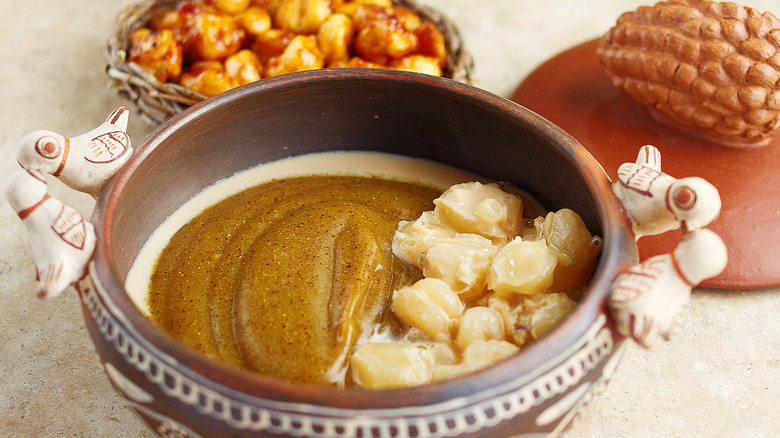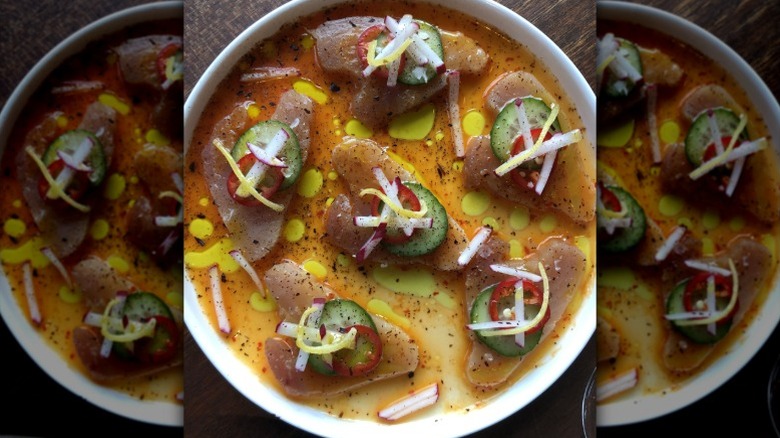The 5 Global Influences Found In Peruvian Food
People love to say that the United States is a melting pot of different global cultures, but the cuisine of Peru might just give the U.S. a run for its money. The coastal South American country, home to the Andes Mountains and parts of the Amazon River basin, has been influenced by a number of countries due to a history of immigration and colonization going back hundreds of years. In fact, it goes all the way back to the start of the Inca Empire.
You might not know the cultural footprint Peru has made on our modern-day eating habits, but popular foods like corn, quinoa, and potatoes are all indigenous to the area. These humble but mighty staples have gone on to find their way into other cuisines around the globe. These native ingredients serve as the base that combines the many influences brought by global settlers and conquerors. These influences include Arab, African, Chinese, Japanese, and Spanish cuisine, with each one helping to make Peruvian food a diverse, one-of-a-kind experience.
The Spanish influence that started it all
The Spanish had the biggest impact on Peruvian cuisine dating back to their colonization in the area starting in 1526. The classic dish of raw seafood marinated in lime juice and chilis known as ceviche (not to be confused with aguachile) is often served in Mexican restaurants, but it was because of Spanish influence and the coastal region's abundant seafood that Peru calls it their national dish today.
It was in Peru where the name leche di tigre, or "tiger's milk", was coined in reference to ceviche's sour and spicy marinade. The remaining leche de tigre is often served as a shot which is sometimes spiked with Pisco (an unaged Peruvian brandy) either at the end of the meal or as a hangover cure. Other Spanish-inspired dishes include Rocoto Relleno, a stuffed fried pepper much like the well-known chili relleno, and Papas a la Huancaina which are small-cut potatoes fried and served with a spicy cheese sauce in a similar fashion to patatas bravas.
Chinese influence
Another popular Peruvian dish called lomo saltado comes from the direct influence of Chinese immigration, which started in 1847 when the Spanish colonizers shipped in workers from across Asia, including China, Malaysia, and the Philippines. Lomo saltado consists of stir-fried slices of steak seasoned with soy sauce, garlic, tomatoes, bell pepper slices, and onions all mixed with crispy french fries and cooked in a wok (like many Chinese dishes). This is often served alongside rice or noodles and makes for a crowd-pleasing dish that's also great drunk food.
Lomo saltado is a prime example of what is referred to as Chifa, the name for the hybrid of Chinese and Peruvian cuisines. Another emblematic dish of Chifa is arroz chaufa, a Peruvian incarnation of the Chinese takeout staple, fried rice. Although the ingredients used in arroz chaufa can vary just as widely as it can in fried rice, the Peruvian version often uses seafood because of the area's deep ties to fishing.
Arabic and Moorish flavors in Peruvian food
The influence of Arab and Moorish culture on Spanish society also made its way into the cuisine and introduced the region to traditional Arabic ingredients like lemons, dates, almonds, and spices such as saffron and coriander. Aji de Gallina is a quintessential example of Arabic influence in Peruvian food. It's like a curry made of stewed chicken in a creamy sauce of milk thickened with almonds and bread and seasoned with Arabic spices like saffron and a local breed of sweet yellow peppers, aji amarillo. This stew is served over boiled potatoes with a side of steamed rice and slices of hard-boiled eggs on top.
Other dishes, like Peruvian machauwis, closely resemble Middle Eastern shish kebabs in that they're seasoned meats grilled on metal skewers. Arroz Árabe, literally translated as Arab rice, is a dish of seasoned steamed rice served at Christmas time. It also uses many of the aforementioned Arabic spices.
African traditions in Peruvian food
Enslaved Africans were brought over as workers for early settlements and coastal plantations in Peru as early as 1521. This introduced an entirely different style of food and culture than the northern African influence of Arab and Moorish communities. Tacu tacu is a traditional dish that uses leftovers. It's often made of rice, beans, and vegetables mashed together and fried in a skillet like fritters. It's one of the more popular examples of pan-African cuisine in Peru because of its versatility in being able to utilize any leftovers on hand.
Stews like carapulcra were developed by Africans in slavery who used the cultural ingredients they brought with them from their home continent. These ingredients included peanuts and spices like cinnamon and cumin which are used to flavor the hearty pork stew. Cau cau is spiced similarly but made with a base of beef tripe, inspired by a popular South African stew.
Japanese cooking methods
Peru is home to the second-largest population of Japanese immigrants in South America, falling only behind Brazil. These people came over toward the end of the 19th century. Known as the Nikkei community, the cultural crossover helped to bring Japanese methods of cooking to Peruvian ingredients. This influence is best shown in a dish called tiratido, which is similar to ceviche and made of raw fish in a tangy chili sauce. The key difference is how the fish is sliced thin like sashimi instead of cubed for ceviche, and the fish in tiratido is not marinated to "cook" the fish like in ceviche.
Nigirizushi, a rather obvious reference to nigiri, is much like the Japanese style of sushi including slices of raw fish on top of mounds of cooked white rice, but in this case the rice is seasoned with local flavors like aji amarillo and lime. There are also the prime fusions of Spanish and Japanese cuisines in maki acevichado, which are sushi rolls filled with ceviche.
